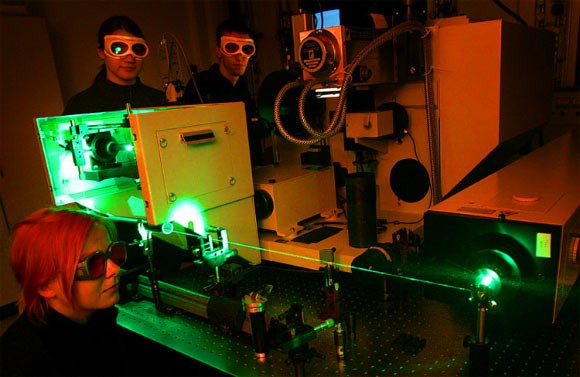Scientists Develop Random Raman Laser to Reveal Microscopic Life
| Marco Foronda | | May 05, 2015 10:40 AM EDT |
(Photo : Research Group Materials for Microelectronic Applications / TU Bergakademie Freiberg) Scientists demonstrated how a narrow-band strobe light source for speckle-free imaging has the potential to reveal microscopic forms of life.
Scientists have developed a “random Raman laser”, which can be a promising application in a high-speed wide-field microscopy that can have a big potential in revealing secrets of the unseen world.
Microscopic imaging techniques use lasers as light sources because of their ability to deliver pulses of intense radiation to a target that allows ultra-fast image acquisition. The said technique also has disadvantages as it produces images that are blurred by speckled patterns.
Like Us on Facebook
Speckles happen because of a property of conventional lasers called “high spatial coherence”. Researchers used a laser-like light source that has a “low spatial coherence” to make a remedy for this.
The remedy just want to show a new light source that would have electric fields at different positions in the light beans and do not oscillate in the lockstep as what they usually do in a traditional lasers. The random Raman lasing emission does offer a bright, speckle-free, strobe light source.
“We found that random Raman lasing emission has a low level of spatial coherence. The emission can be used to produce a wide-field speckle-free quality image with a strobe time on the order of a nanosecond. This new, bright, fast, narrowband, low-coherence light source opens the door to many exciting new applications in bio-imaging such as high-speed, wide-field microscopy,” said Brett Hokr, a physicist at Texas A&M University and the lead author of the research.
The new technique does cause a diffuse material such as powder in order to emit laser light and is different from conventional last that bounce photons back and forth in a laser cavity.
In the final approach, researchers test the effectiveness of the technique and was able to produce a “full-frame, speckle-free microscopic image” that show the formation of a cavitations bubble from a melanosomes.
Details of the study appeared in the journal Optical Society.
TagsScientists Develop Random Raman Laser to Reveal Microscopic Life, laser, Microscopic Life, Random Raman Laser, Microscopy Technique
©2015 Chinatopix All rights reserved. Do not reproduce without permission
EDITOR'S PICKS
-

Did the Trump administration just announce plans for a trade war with ‘hostile’ China and Russia?
-

US Senate passes Taiwan travel bill slammed by China
-

As Yan Sihong’s family grieves, here are other Chinese students who went missing abroad. Some have never been found
-

Beijing blasts Western critics who ‘smear China’ with the term sharp power
-

China Envoy Seeks to Defuse Tensions With U.S. as a Trade War Brews
-

Singapore's Deputy PM Provides Bitcoin Vote of Confidence Amid China's Blanket Bans
-

China warns investors over risks in overseas virtual currency trading
-

Chinese government most trustworthy: survey
-

Kashima Antlers On Course For Back-To-Back Titles
MOST POPULAR
LATEST NEWS
Zhou Yongkang: China's Former Security Chief Sentenced to Life in Prison

China's former Chief of the Ministry of Public Security, Zhou Yongkang, has been given a life sentence after he was found guilty of abusing his office, bribery and deliberately ... Full Article
TRENDING STORY

China Pork Prices Expected to Stabilize As The Supplies Recover

Elephone P9000 Smartphone is now on Sale on Amazon India

There's a Big Chance Cliffhangers Won't Still Be Resolved When Grey's Anatomy Season 13 Returns

Supreme Court Ruled on Samsung vs Apple Dispute for Patent Infringement

Microsoft Surface Pro 5 Rumors and Release Date: What is the Latest?










